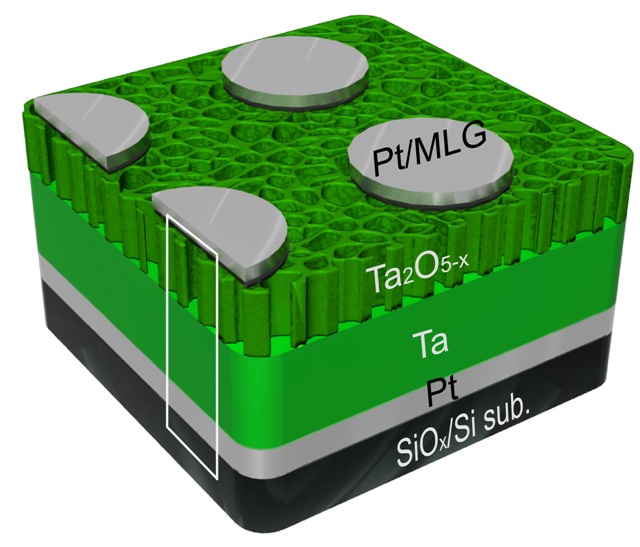A team of researchers at Rice University has developed an advanced solid-state memory technology that enables high-density data storage without causing any major computer errors. The memory device resolves crosstalk issues, which promote read errors in other devices. These memories are built on tantalum oxide - a standard insulator used in electronics.
 A schematic shows the layered structure of tantalum oxide, multilayer graphene and platinum used for a new type of memory developed at Rice University. The memory device overcomes crosstalk problems that cause read errors in other devices. (Credit: Tour Group/Rice University)
A schematic shows the layered structure of tantalum oxide, multilayer graphene and platinum used for a new type of memory developed at Rice University. The memory device overcomes crosstalk problems that cause read errors in other devices. (Credit: Tour Group/Rice University)
When voltage is applied to a 250nm thick layer of graphene, platinum, tantalum and nanoporous tantalum oxide, addressable bits are produced where the layers join. The bits are switched between zeroes and ones by control voltages, which shift oxygen ions and vacancies. This latest breakthrough made at chemist James Tour’s Rice lab could pave the way for crossbar array memories that can store as much as 162GBs, which are relatively higher when compared to other oxide-based memory units being studied by researchers. Eight bits are equivalent to one byte, and a 162-GB unit can store approximately 20GBs of data. Details of the study have been published in the American Chemical Society journal Nano Letters.
Previously, the Tour’s lab had discovered silicon oxide memories. Similar to these silicon oxide memories, the latest devices need only a pair of electrodes for each circuit. This makes these devices comparatively simpler than today’s flash memories, which utilize three electrodes.“But this is a new way to make ultradense, nonvolatile computer memory,” Tour said.
Nonvolatile memories are different from volatile random-access computer memories, which tend to lose their data when the system is shut down. The former retains their information even when the power is switched off,
Contemporary memory chips involve a number of requirements. For instance, they have to both write and read information at relatively high speed and must hold maximum amount of data. The chips should also last for a long time and demonstrate excellent data retention while consuming reduced power.
Two movies show the partially interconnected and randomly distributed internal pores in new memory devices created at Rice University.
Tour stated that the latest design developed by Rice researchers holds promise in meeting all these requirements as it consumes only minimal power when compared to other existing devices.
This tantalum memory is based on two-terminal systems, so it’s all set for 3-D memory stacks. It doesn’t even need diodes or selectors, making it one of the easiest ultradense memories to construct. This will be a real competitor for the growing memory demands in high-definition video storage and server arrays.
The layered structure includes a multilayer graphene, tantalum, and nanoporous tantalum oxide between a pair of platinum electrodes. While fabricating the material, the scientists discovered that the tantalum oxide steadily loses oxygen ions and eventually changes to oxygen-poor nanoporous semiconductor at the bottom from an oxygen-rich, nanoporous semiconductor at the top. Once the oxygen disappears fully, the tantalum oxide becomes a pure tantalum metal.
The research team found that three related factors render a special switching ability to the memories. Firstly, the control voltage intercedes how electrons passing via a boundary can switch from an ohmic to a Schottky contact and vice versa. Secondly, depending on oxygen vacancies the location of the boundary can alter. These vacancies are holes in atomic arrays where oxygen ions are believed to be present, but actually do not exist. The movement of oxygen vacancies controlled via voltage moves the boundary from the interface of tantalum and tantalum oxide to the interface of graphene and tantalum oxide. Thirdly, the current flow attracts oxygen ions from the tantalum oxide nanopores and ultimately stabilizes them. These ions which are negatively charged create an electric field that acts as a diode to prevent error-causing crosstalk. Although scientists are aware about the possible value of using tantalum oxide for memories, these arrays have been mostly restricted to a kilobyte, as denser memories are known to experience crosstalk, resulting in bits being misread.
“The exchange of contact barriers causes the bipolar switching,” said Gunuk Wang, former postdoctoral researcher at Rice and lead author of the study.
The graphene functions as a barrier which not only prevents platinum from moving into the tantalum oxide, but also prevents a short circuit. According to Tour, it is possible to fabricate tantalum oxide memories at room temperature. It is also possible to adjust the control voltage which writes and rewrites the bits, thus enabling a broad range of switching properties.
Wang added that the remaining barriers to commercialization of tantalum oxide memories are the development of adequately dense crossbar device to deal with separate bits and a means to regulate the nanopore size.
Study co-authors include Jae-Hwang Lee, former Rice research scientist and an assistant professor of mechanical and industrial engineering at the University of Massachusetts, Amherst; and Gedeng Ruan, Yang Yang, Yongsung Ji, and Nam Dong Kim, postdoctoral researchers at Rice University.
Tour is the T.T. and W.F. Chao Chair in Chemistry and a professor of materials science and nanoengineering and of computer science. He is also a member of Rice’s Richard E. Smalley Institute for Nanoscale Science and Technology. Wang is an assistant professor at Graduate School of Converging Science and Technology of the Korea University-Korea Institute of Science and Technology.
References